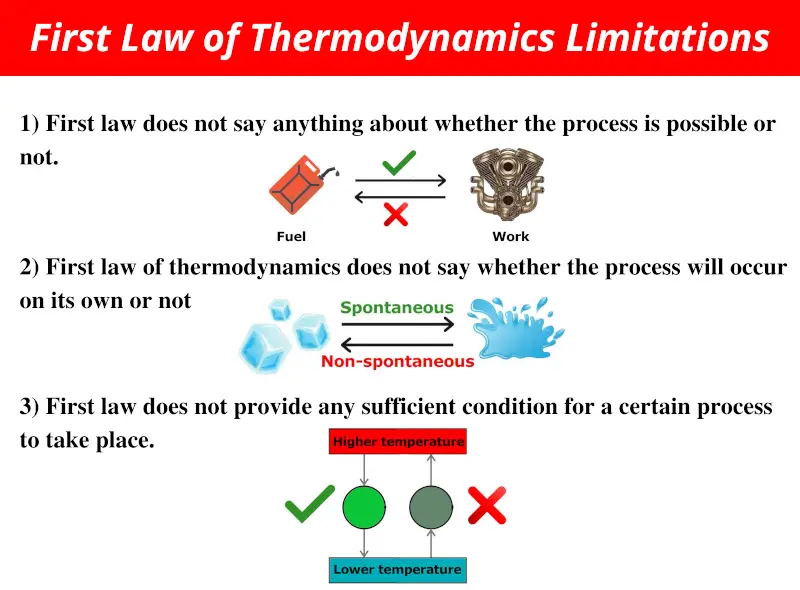Nothing quite exemplifies the first law of thermodynamics as well as a gas like air or helium trapped in a container with a tightly fitting movable piston as seen below. The differential form of the first law of thermodynamics can be seen below.

Limitations Of First Law Of Thermodynamics Very Easy
It states that energy cannot be created nor destroyed.

. The equation for the first law of thermodynamics is given as. Examples of the First Law of Thermodynamics and the Conservation of Energy. The First Law of Thermodynamics Work and heat are two ways of transfering energy between a system and the environment causing the systems energy to change.
An example is when the chlorophyll absorbs light and transforms it. Last lecture we saw that adding heat to an object does not always change the temperature of the object In some cases the heat causes a phase changeinstead. When an engine burns fuel it converts the energy stored in the fuels chemical bonds into useful mechanical work and into heat.
The First Law of Thermodynamics. Gasoline is a thermodynamic system that reacts with oxygen generating a spark that produces combustion. According to the first law of thermodynamics energy can be transferred from place to place or changed between different forms but it cannot be created or destroyed.
Metabolism is an interesting example of the first law of thermodynamics in action. Energy Flow in a Diesel Engine. This reaction moves a piston that is responsible for the movement of the cars wheels work.
In a non-flow process there is heat transfer loss of 1055 kJ and an internal energy increase of 210 kJ. The first law of thermodynamics. One example of how the First Law of Thermodynamics acts is the perpetual motion machine.
An example of the first law of thermodynamics is when a gas stove transforms chemical energy from natural gas into heat energy. The laws of thermodynamics dictate energy behavior for example how and why heat which is a form of energy transfers between different objects. For instance light bulbs transform electrical energy into light energy and gas stoves transform chemical energy from natural gas into heat energy.
U Q- W. The first law of thermodynamics is the law of the conservation of energy. The total energy of an isolated system is neither created nor destroyed the amount of energy remains constant.
This means that heat energy cannot be created or destroyed. 3 rows Metabolism is an interesting example of the first law of thermodynamics in action. Q algebraic sum of heat transfer between system and surroundings.
W work interaction of the system with its surroundings. In the case of the work done in a hydrostatic system. This expression can be used alongside the ideal gas law to describe the thermodynamic processes in heat engines.
Well assume the piston can move up and down compressing the gas or allowing the gas to expand but no gas is allowed to escape the container. The first law of thermodynamics Shown are two examples of energy being transferred from one system to another and transformed from one form to another. Determine the work transfer and state whether the process is an expansion or compressionThe first law of thermodynamics 1.
ΔU q W. Lets imagine the engine of a car. The first law of thermodynamics states that the change in internal energy for a system is equal to the heat transfer to the system minus the work done by the system on its surroundings.
However much energy there was at the start of the universe there will be that amount at the end. Different types of fuel have different amounts of energy but in any given gallon or liter of fuel there is a set amount of energy. The First Law of Thermodynamics.
Examples of the First Law of Thermodynamics. Where ΔU change in internal energy of the system. Example of the first law of thermodynamics The energy in gasoline is transformed into movement and heat.
It can however be transferred from one location to another and converted to and from other forms of energy. Manual 6 First Law of Thermodynamics NFEE Applications 41 First Law of Thermodynamics NFEE Applications 1. Humans can convert the chemical energy in food like this ice cream cone into kinetic energy by riding a bicycle.
The differential form of the equation is used to describe in more detail the rate of change of heat and work and as an extension the rate of change of a system s internal energy. We now take another look at these topics via the first law of thermodynamics. The negative sign indicates that the reaction is exothermic.
The first law of thermodynamics is generally thought to be the least demanding to grasp as it is an extension of the law of conservation of energy meaning that energy can be neither created nor destroyed. The First Law of Thermodynamics states that heat is a form of energy and thermodynamic processes are therefore subject to the principle of conservation of energy. First law of thermodynamics in differential form.
The first law of thermodynamics states. For example the enthalpy change for the formation of water from hydrogen and oxygen gases is -285 kJ per mole of liquid water. Bahman Zohuri in Physics of Cryogenics 2018.
This means that water has less energy stored in it than does the hydrogen and oxygen gases from which it was formed. If the system as a whole is at rest so that the bulk mechanical energy due to translational or rotational motion is. The First Law of Thermodynamics requires that the total energy of your body muscles and palms is the same both before and after you rub them together.
Considering the body as the system of interest we can use the first law to examine heat transfer doing work and internal energy in activities ranging from sleep to heavy exercise. Example is ice melting solid liquid phase change for water while the ice melting the icewater. First Law of Thermodynamics Equation.
The First Law Of Thermodynamics Introduction To Chemistry


0 Comments